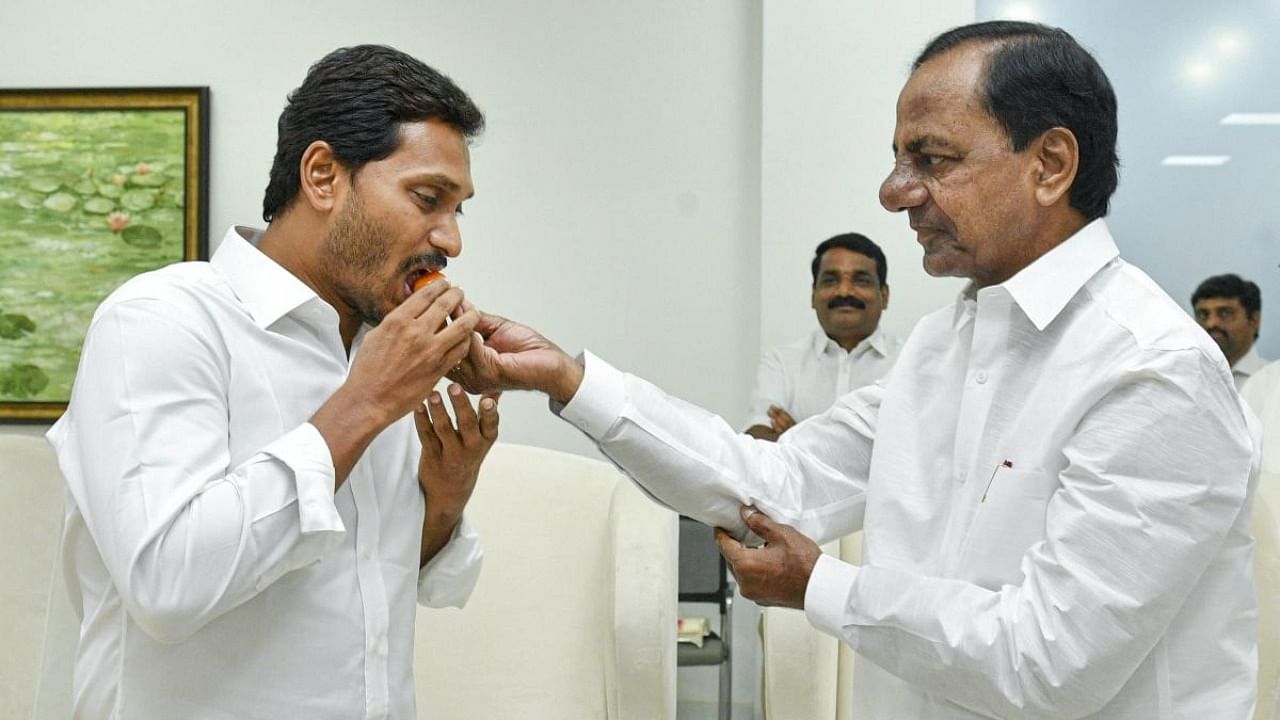
Within a month of becoming Chief Minister of Andhra Pradesh in mid-2019, Y S Jaganmohan Reddy went to Pragathi Bhavan, the palatial official residence-cum-operating space of his Telangana counterpart K Chandrasekhar Rao in Hyderabad.
The two held drawn-out discussions over many thorny issues between the two Telugu states, prominent among them being river water-sharing.
The talks were held in a cheerful environment with a “give and take” approach – a welcome shift from the confrontations during the tenure of former Andhra CM Chandrababu Naidu – and Reddy’s team was served the best of Telangana cuisine.
While resolving to amicably settle all pending matters related to the 2014 bifurcation of the erstwhile Andhra Pradesh, Rao and Reddy had even discussed an ambitious plan to lift Godavari waters to the Krishna basin through Telangana, to water the parche d regions on both sides.
A week prior to the meeting, Reddy, upon Rao’s invitation when the latter visited his Amaravati residence, had attended the inauguration of the Kaleshwaram lift irrigation project on the Godavari in Telangana. Reddy also handed over to his counterpart Andhra Pradesh’s share of the Hyderabad secretariat buildings, allowing Rao to proceed with his plans for a grand, new Telangana secreta riat.
The bonhomie paved the way for further parleys between the two CMs in August and September that year, to firm up ideas like the Godavari-Krishna interlinking.
Former CM Naidu had, however, slammed the “friendship” and expressed apprehensions over the project, which he said could cost up to Rs 1.5 lakh crore and required water to flow through Telangana.
“Today, you (Reddy) have cordial relations with the Telangana CM, but neither of you are permanent in the post. There will be a change of guard and there could be water disputes,” Naidu had said then, accusing Reddy of pledging Andhra Pradesh’s interests.
Naidu’s prophecy seems to be coming true, within the tenure of the two chief ministers, and proving that a peaceful settlement of water disputes between states is hard to come by.
The Rao and Reddy governments are now squabbling more bitterly than the two governments did during even Naidu’s time, accusing each other of building unauthorised projects, and each claiming more rights over the Krishna river that straddles the two states.
While the consultations held by the Centre through the Union Water Resources minister-chaired apex council are often unfruitful because of this tiff, the two sides are engaged in a legal face-off, too, waging cases in the apex court and tribunals.
Within five months of gracing the Kaleshwaram event as a special guest, the Reddy government had in November 2019 raised objection s to the mega lift irrigation project in the Supreme Court, stating that its restructuring would be detrimental to Andhra’s irrigation interests.
What has aggravated the water war between the two sides is the YSRCP government’s May 2020 order allocating Rs 6,829 crore for the Rayalaseema Lift Irrigation Scheme (RLIS) and supporting the canal system to draw three TMC per day from the Pothireddypadu Head Regulator on the Srisailam reservoir.
While Andhra says that RLIS is essential to provide water for the chronically drought-prone Kurnool, Kadapa, Anantapur, Chittoor, Nellore and Prakasam districts, Telangana says the project is in violation of the AP State Reorganisation Act, 2014, and has appealed to the Centre, the Krishna River Management Board (KRMB) and the National Green Tribunal to stop “the illegal construction activity.”
Some of the TRS ministers have accused Reddy and his father – the late chief minister of undivided AP, Y S Rajasekhara Reddy -- of stealing Telangana’s share of waters, attracting sharp reactions from YSRCP ministers.
Reddy charged that Telangana is already constructing the “unauthorised” Palamuru Ranga Reddy, Dindi and other lift irrigation schemes, despite Andhra’s repeated complaints to KRMB.
The issue precipitated in June with Telangana using the Krishna waters to generate power at Srisailam, Nagarjuna Sagar and Pulichintala projects, following Rao’s orders.
A tense situation prevailed, with police forces deployed on both sides of the projects, which are under shared control of the Andhra and Telangana governments.
The scene was reminiscent of those from 2015, when the irrigation project officials of the two states were engaged in heated arguments and cops from the two states came to blows on the Nagarjuna Sagar dam because of the stiff stand taken by the then chief ministers – Naidu and Rao -- over water-sharing.
Complaining that Telangana’s “unilateral withdrawals” from dead storage levels for electricity were resulting in wastage of precious waters, Reddy shot off a letter to Prime Minister Narendra Modi, seeking CISF protection at the common reservoirs to safeguard AP’s i nterests.
Amid the row, the Centre had in July notified the jurisdictions of the Godavari and Krishna river management boards for the equitable management of the projects on the two rivers in the two states.
However, the two governments continue to wrangle. “Because of the central government’s anti-Telangana attitude and AP’s dadagiri (strong armed action), we could face problems in future with availability of Krishna waters,” said Rao, addressing a rally near Nagarjuna Sagar in August. Rao reiterated that the“injustices meted out to Telangana in river water allocation had resulted in separate statehood movement.”
Reddy has asserted that his state will draw its rightful share of river waters in the interest of its farmers while maintaining that he wants cordial relations with neighbouring states.
While the present sharing arrangement of the 811 TMC Krishna waters is in a 66:34 ratio between Andhra and Telangana, Rao now wants this to become 50:50, while Reddy wants the distribution revised to 70:30. A meeting of the Krishna River Management Board, now re-scheduled to September 1, could see some more sparks fly over the matter.
If this is the state of affairs when there are plentiful rains and copious inflows into the reservoirs, analysts are worried about what would happen in rain-deficit years.